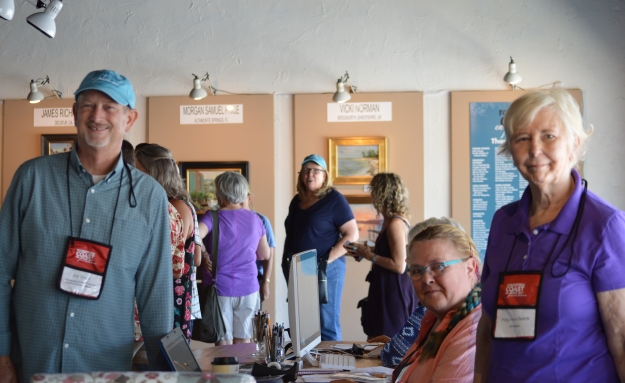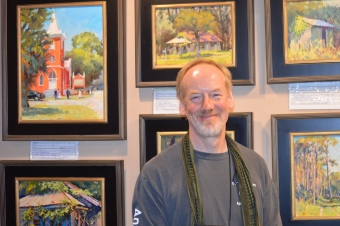The Vision
The festival, billed as “America’s Great Paint-out,” brings invited artists into its heart for ten days each May, into an area rich with its own culture, into a setting vivid and rare.
The Setting
Picture Highway 98, running along the coast on the Florida panhandle. Between Carrabelle to the east and Mexico Beach to the west, coastal fishing towns —Eastpoint, Apalachicola, Port St Joe—slow your progress just enough to take in wide expanses of tranquil bays, inlets, and nutrient rich rivers. Views of vast marshlands or the breaking waves of the Gulf of Mexico disappear into dense pine woods for dozens of miles until you come back into the light again, rolling through yet another working village and on, along the causeways and bridges, where the road often adds a flounce of sea along its shoulders.

Joe Taylor, left, Kerry and Pollyanne, right, at the reception desk
The Facilitators
Note the people, too. Two hundred and fifty volunteers make this major event work for the Forgotten Coast Cultural Coalition; they power through eighty-two miles’ worth of venues.
Panel discussions, one-on-ones, receptions and artist demos are scattered all along this stretch of highway. The artists have infinite subjects: working shrimp boats, white-sand beaches, sailboats half afloat, shotgun homes, and shady vintage porches wait their turns.
Completed paintings flood into the Joe, the wetroom in Port St. Joe, where one of the lead volunteers and Vice President of the Coalition, Joe Taylor, explained that, just as Apalachicola is known as “Apalach,” Port St. Joe is called the “Joe” by locals. The refurbished storefront also known as the “Joe” is new home to the event, a labor of love for Council president Susan Bassett, who negotiated the lease with an offer to purchase option.
The Coalition’s mission is the advancement of culture through art enrichment and community involvement. Invited artists are charged with sharing knowledge, answering questions, and inspiring conversations.
The Judging
Panel discussions were led by Lori Putnam, who was also tasked with judging. Her presentation on the subject began by urging artists to consider “going pro,” and allowing more new artists to compete in open class, citing the difficulties she encounters in the process of recognizing and awarding newer talent.
Putnam’s open class selections are based on strong patterns of light and dark—and the use of warms and cools for both—as well as design and drawing skill, hard and soft edges, mood, and details that are not overdone. “Tight,” she said, “but not tiring.”
Her professional class selections are based on more stringent criteria, such as how a painting leads the eye through itself. She likes to see artists who break the rules, but with subtlety and strength in their compositions, and she urges abstraction first. “Tell a lie,” she said, “and make it work, but no corny stuff.” Painters in the audience were encouraged to “bother” the invited and the “Florida’s Finest” ambassador artists wherever they found them and, for growth, to watch them paint.

Tony Robinson with a few of his paintings
A Sampling of the Artists
One of the panel discussions Lori Putnam led included Tony Robinson, Debra Huse, Mark Fehlman, and Nancie King Mertz, on the art of storytelling through plein air painting. Putnam drew the artists out through a series of questions, getting their backgrounds, painting preferences, and humorous events from each.
Tony Robinson, who lives in Ireland, likes to paint alleys and bars, and is drawn to people, who often populate his paintings. His mid-summer “Art in the Open” (www.artintheopen.org) festival, held in southeast Ireland was an effort, he said, “to find artists who did this gritty plein air thing.” His painting advice includes “going for the particular,” and he urges newcomers to find perspective simply, by using overlapping shapes.
Debra Huse, an Indianapolis native, grew up drawing at the Indy 500. She now lives in California and works out of a studio in a boatyard. She loves boats and their histories, and was moved by Alabama shrimpers who spent an hour talking with her during the Forgotten Coast event.
Mark Fehlman always wanted to be an architect, and learned to draw in a way that allowed clients to trust him, thus moving his design forward. Now a full-time California artist, he said he’d be fulfilled just painting the houses of Apalachicola, that he tries to find beauty or a message in everything he looks at, and aims to “present them as elegant.”
Nancie King Mertz, of Chicago, took an architecture class in college, and she said that she’s fascinated by light and shadow in structures, especially bridges. “The rustier, the better,” she said. In response to Putnam’s final question, asking artists how they felt about the concept of artists as historians, she agreed. “We are historians in some respects,” she said, noting disappearing landmark structures in Chicago.
Fehlman spoke on the humanity and variety of old houses on the Forgotten Coast, and referred to artists as “the chroniclers of history.” Huse spoke of honoring the old boats before they’re gone, and the changes she’s noted in vanishing landscapes. She feels that plein air painting adds to the community and the conversations found within it.
Robinson does not think of himself as a “recordist,” at least not consciously. He agrees that his work has some of that effect, but believes that he doesn’t have answers about the importance of what it is that he does.
The Results
On Sunday, May 13th, the Joe was decked out. Goblets and plates alike were colored in jewel tones—fruit, fish, and pastries reflecting the rich and abundant paintings.
Joe Taylor, adjusting a microphone for one of the final presenters, made time to tell me: “Encourage people to come.”
Go to www.forgottencoastenpleinair.com and click on “Art” to view the work.
